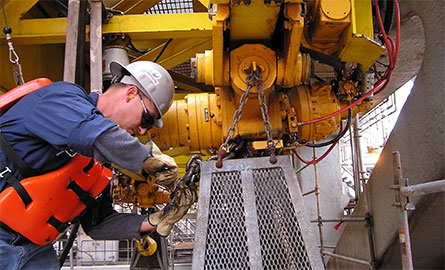Inspection and Modernization
BLP Services offers inspection and testing of lifting equipment in accordance with current industry standards and manufacturers recommendations. We specialize in rig pass certification, slings and loose lifting gear, pad eye/lug, bridge crane, jib crane, davit crane, and gantry crane inspections and testing.
Visual inspections shall always precede any maintenance, repair, testing, or any new device being put into service. Our inspectors perform thorough written examinations that we call a “link by link” inspection with extreme scrutiny.
Proof Testing is an integral component of an inspection program. Our customers may choose proof test lifting equipment at given intervals, or for verification purposes because of recent repair, recertification, or dormancy. Our fleet of proof testers, load cells, weights, and rigging equipment enable us to proof test most all types of common lifting equipment.
One unique service we offer Gulf of Mexico customers is the BLP Services “Rigging Gear Registry” program. The “Rigging Gear Registry” program organizes your lifting assets by location, description, serial number, and condition, and produces an inspection report on paper and in electronic format for your record keeping. The inspection report also notes the standard on which each piece is inspected in the event the inspection findings need to be verified.
Some of our Services
Crane & Hoist
Hoist and Crane inspections or testing are performed in accordance with applicable ASME B30, API, OSHA 1910/1926, CMAA 70/74, SNT-TC-1A, current industry standards, and manufacturers recommendations. A thorough visual examination is critical and required on all hoists and cranes with specific frequencies. Wire Rope and Hooks on cranes shall be inspected monthly according to ASME B30 standards.
Slings & Loose Lifting Gear
With our origins in sling fabrication and lifting devices, our inspectors have industry leading experience and training. Slings and loose lifting gear are often overlooked and should be maintained with a regimented inspection program to assure compliance. Proof Testing of slings and loose lifting gear is also very common and recommended. Our portable proof testing equipment lets us come to you and minimizes down time.
Lifting Devices & Heavy Equipment
BLP Services inspects and tests Material Baskets, Personnel Baskets, Forklifts, Aerial Lifts, and other miscellaneous lifting equipment. ASME B30.20 Below-the-Hook Lifting Devices defines the inspection, testing, and removal from service criteria. Our inspectors inspect and proof test lifting devices in accordance with this standard.
Lifting Magnets - Repair & Recertify
There have been recent changes to magnet inspections and testing that everyone needs to be aware of. The ASME B20.20-2018 standard states Lifting Magnets should have an annual Breakaway Test to verify the magnet meets its design factor. To schedule call with our service department, please fill out the form below to be contacted.


Repair & Recertification
Houston, Texas's top service center for plate clamp repair and hoist repair! Our qualified service technicians have years of industry experience and have been trained and certified to inspect, repair and recertify the industry leading brands of plate clamps, lifting magnets and hoists.
Plate Clamp Repair
- Repair for plate lifting clamps aka plate dogs
- Complete disassembly, thorough inspection, replacement of worn parts: cams, pins, jaws, pads, shackles.
- Paint, replace data plates, color coding if needed
- Proof testing according to ASME B30.20 Below-the-hook standard
- Brands: JC Renfroe IP Clamps Safety Clamps Campbell Merrill

Hoist Repair
- Repair for lever chain hoists, hand chain hoists, electric hoists, air hoists, trolleys and more!
- Complete disassembly, thorough inspection, replacement of worn parts: load chain, hand chain, hooks, latches, bearings, pawls, gears
- Paint, replace data plates, color coding if needed
- Proof testing according to applicable ASME B30 standards
- Brands: Harrington CM Coffing Chester Inquire on other brands

Lifting Magnet Repair
- Complete disassembly, thorough inspection, replacement of worn parts: handles, internal mechanical parts.
- Paint, replace data plates, color coding if needed
- Proof testing according to applicable ASME B30.20 Below-the-hook standard
- Brands:
Eriez
Walker
Industrial Magnetics
Inquire on other brands

Proof Testing
Proof Test Services available at all Bishop Lifting branches At Bishop Lifting, slings, wire rope, rigging hardware, mooring lines, oilfield equipment, and structural components are all proof tested or load tested to validate the overall integrity of the item. This integrity is based on the material of the item, as well as the splices, welds, epoxy, stitching, or swaging used for terminations. These items are load tested to a predetermined percentage above the rated capacity recommended by the manufacturer, ASME B30.9 Slings standard, API standards, or customer specific policies. The proof test serves as a pass or fail certificate at the time of test.
More and more customers are now requiring proof testing on all slings. Proof Testing was driven by the offshore drilling industry and is mandated in the ASME B30.0 “Slings” standard on alloy chain slings, metal mesh slings, and any sling that has been modified or repaired. Our largest proof test bed can test up to 3.3 million pounds (1500 metric tons). With an overall length of 323 feet, and inside pulling length of around 275 feet located in Houston, TX. Third Party witness testing is available if necessary.
Pad Eye Testing
- Hydraulic Pad Eye Testing
- Lifting Lugs
- Hydraulic Trunnion Testing
- Welded in Fixtures
Non-Destructive (NDT) Testing
- Magnetic Particle Inspection
- Liquid Dye Penetrant
- Ultra Sound
- On-site Services Available
DNV Testing
- Witnessed by 3rd party DNV-GL auditor
Vertical Testing
- Vertical testing capacity up to 100K lbs.
- Used for testing chain hoists
Types of Testing Provided
- Proof Load
- Cycle Testing
- Yield Testing
- Break Testing
- Extended Hold Testing
- Strain Gauge Testing
Access our online database of test certificates at: www.prooftesting.com.
Access our PDF for more information: More Info


Customer Care Center

Access your rigging item detail, certificates and wireline service tickets.
Sign In

